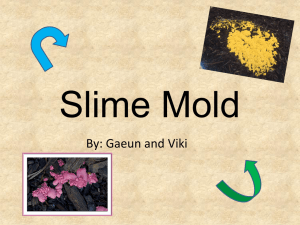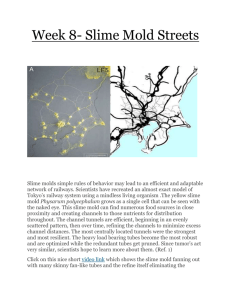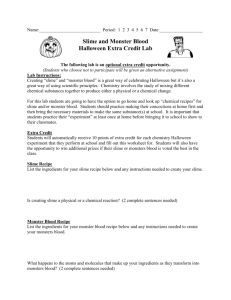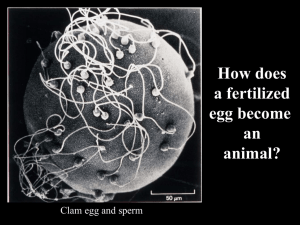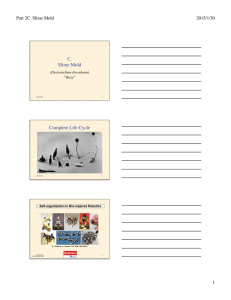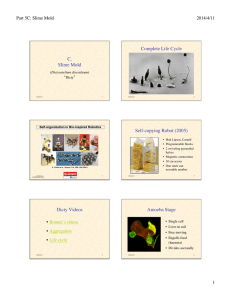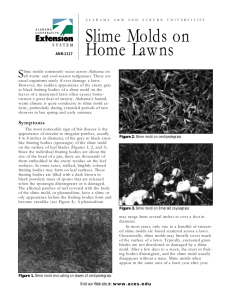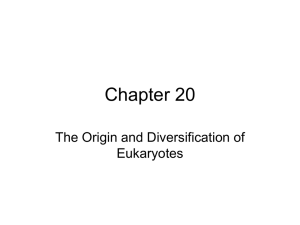How Cellular Slime Mold Changed My Life
advertisement
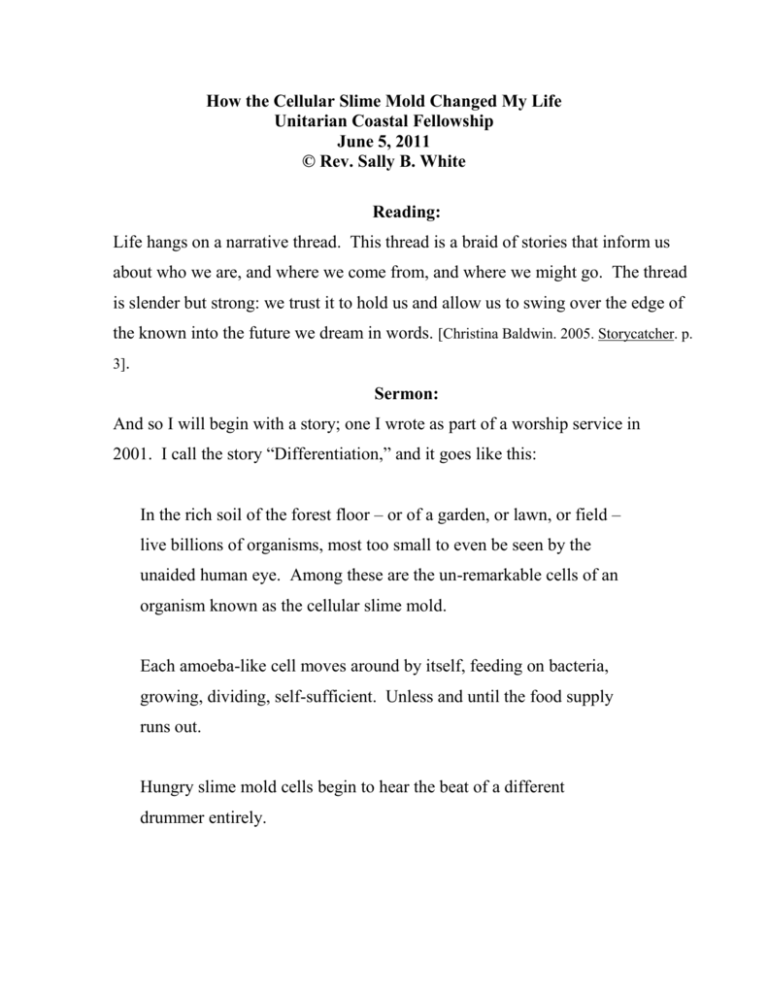
How the Cellular Slime Mold Changed My Life Unitarian Coastal Fellowship June 5, 2011 © Rev. Sally B. White Reading: Life hangs on a narrative thread. This thread is a braid of stories that inform us about who we are, and where we come from, and where we might go. The thread is slender but strong: we trust it to hold us and allow us to swing over the edge of the known into the future we dream in words. [Christina Baldwin. 2005. Storycatcher. p. 3]. Sermon: And so I will begin with a story; one I wrote as part of a worship service in 2001. I call the story “Differentiation,” and it goes like this: In the rich soil of the forest floor – or of a garden, or lawn, or field – live billions of organisms, most too small to even be seen by the unaided human eye. Among these are the un-remarkable cells of an organism known as the cellular slime mold. Each amoeba-like cell moves around by itself, feeding on bacteria, growing, dividing, self-sufficient. Unless and until the food supply runs out. Hungry slime mold cells begin to hear the beat of a different drummer entirely. 2 When there is no ready food for them to eat, these individual cells begin to produce a new chemical, one that signals and attracts other slime mold amoebae, just like itself. Millions and billions of cells begin to gather, moving toward one another, congregating, responding to the chemical distress signal, and propagating it themselves. And then comes the most amazing thing. Clumps of cells begin to form, and they organize themselves into minute, shimmering, sluglike aggregates, and these aggregates begin to move, migrating in search of a new supply of food. If they encounter a rich new food supply, the aggregate disbands, and the cells resume their independent existence, eating, growing, dividing. But if they do not find food, then a further transformation occurs, and this one is not reversible. Migration stops, and the cells of the slug, functioning now not as independent amoebae but as interdependent parts of a greater whole, begin to take on new and different identities. The slug begins a slow and beautiful sort of headstand, and different groups of cells take on different functions. Those at the very tip anchor the group to the soil, or the surface of a leaf. Those in the middle produce cellulose, and form a hollow stalk, no longer capable of eating or reproducing. And those cells that were at the end of the slug become tiny, colored spores, gathered into a glistening and fragrant ball on the top of the stalk, dormant until a drop of rain should knock them down again to the forest floor, where 3 they can germinate and resume the self-sufficient life of an independent amoeba. In times of plenty, slime mold cells are free-living, independent, selfsufficient. But faced with deprivation they transform, from independence to interdependence, from self-sufficiency to specialization. Only a few will become spores. Only a few of these will germinate. And from these few, lifted and supported on the bodies of their neighbors, will come a new generation, the living legacy of each, and of all. It’s a pretty amazing story, isn’t it? It’s got hunger, danger, sacrifice, altruism, and hope –all playing out in a woods or a garden near you, mostly invisible to your eyes. There are obvious parallels to human relationships, and human society. Some of you have heard me talk about these before – the individual in need, calling out to others; the response that gives rise to community, to solidarity; the hunger to be seen and heard and connected that may, in truth, be rooted in our very cells. Just thinking about it is enough to change your life in some ways! And - there’s another dimension yet to my own relationship with the cellular slime mold, and to my own relationship with this story. In what sometimes seems like another life, I was a graduate student studying developmental biology at the University of California at San Diego (UCSD). The cellular slime mold was the research organism I worked with. In the lab, these fungi are a model system for cell differentiation – the process whereby a group of identical cells (like the cells in a developing embryo) develop into different kinds of cells (like muscle, bone, heart, and skin) in a predictable and coordinated way. 4 Put a population of slime mold cells in a Petri dish with plenty of bacteria to eat, and they grow and divide and multiply. Remove the food, and the differentiation process proceeds like clockwork. You can do all kinds of experiments to measure and to manipulate how the cells signal each other, which cells are destined to become base and stalk and spore, how and when the cell changes become irreversible, what’s going on inside and outside and in between the cells. I left graduate school without finishing a Ph.D. For twenty-five years I did other things: I got a teaching certificate and worked as a substitute teacher; I taught introductory biology in a commuter college; I worked as a lab technician in two biology research labs; I worked in a college computer center, a bookstore, a bank. Our children came along – three adopted and one home-grown. Our growing family moved, and moved, and moved. One fateful fall, I was asked if I would teach Sunday School in my Universalist church, and the curriculum, for about 5th and 6th graders, was about evolution. And of course I said yes. And suddenly I was talking science in church! Suddenly, I was challenged – and I was challenging myself – to explore and articulate and share with others the religious dimension of the science I loved. Suddenly, for the first time, I could embrace both the precision of science and my open-ended, open-hearted wonder at the order and the mystery that science seeks to understand. In truth, that Sunday School teaching experience is probably what started me on the road to ministry. But it was fourteen years before I enrolled in seminary. Twenty-two years after leaving graduate school, I went back to California and enrolled in Starr King School, a Unitarian Universalist seminary in Berkeley, to study for the ministry. 5 My fourth and final year of seminary was an internship year. I spent that year at the Unitarian Universalist Church in Monterey, learning by doing to plan worship and to preach, to lead adult learning circles and small ministry groups; to visit sick or lonely parishioners and hospital patients; to officiate at weddings and memorial services; to participate in committee meetings and community outreach programs and a long-range planning process in the way of a minister, which is subtly different than the way of a parishioner. Most important of all, in school and in the parish, I was learning to reflect on the work I was doing: to consider not only the details of “what happened” (in that meeting, that conversation, that service, that class) but also the meaning of “what happened” – for the church, for the participants, for me, inside me. In January 2001, in the middle of the internship year, the interns and our supervising ministers and a member from each internship congregation gathered at Starr King School for a day or two of worship and reflection. Together we considered the details of what was happening in our internships, and we explored the meaning of what was happening: how were churches, ministers, interns being changed by the experience of this year? With two other students, I planned and led a worship service on the theme of “Transformation.” Early one morning, the slime mold story nearly wrote itself. The details of what happened are lovely. People were charmed by the slime mold, by the drama and the sacrifice in the story, by the metaphor of the fragile and delicate balance between independent individuals and 6 interdependent community. One senior minister asked me if he could have a copy of the story. He told it to the congregation in Fairfax, Virginia on their stewardship Sunday, and their Committee on Service Music and Hymnody used the story as the inspiration for new words to the hymn “We Would Be One.” We will sing those words later today, as our closing hymn. Later that spring, I placed the story at the heart of the sermon I preached to the Ministerial Fellowship Committee as they examined my readiness for ministry, and I like to think that sermon is a part of why they declared me to be fully ready. Another student took the story to the editor of Quest, the newsletter of the Unitarian Universalist Church of the Larger Fellowship, and it was published there in the summer of 2001. Those are some of the details of what happened. The meaning of what happened, for me, is more than lovely. It is immensely powerful. There is transformation in it. It was as though the story had been waiting, dormant, inside me for twentytwo years and more. I had long known the facts of slime mold differentiation. Now, suddenly, I had a reason and a framework for making of these facts a story. Now, suddenly, the conditions were just right and I was able to braid together science and wonder and worship into a narrative thread strong enough, trustworthy enough, to swing colleagues and congregations and at least one Committee on Service Music and Hymnody into a new way of being Unitarian Universalist together. Somehow I had woven a thread that proved strong enough to hold me as I swung over the edge of the known into a future in ministry, a future as a minister. 7 And – because the stories we tell tell at least as much about us as they do about “truth,” or “reality,” or the details of what happened, the story itself holds lessons for me, if I am willing to listen to my own story. If I am willing to reflect not only on the details but also on the meaning of the stories we tell, and the stories that tell us. It took me three tries to write that sermon for the Ministerial Fellowship Committee, three tries and the urging of a colleague who advised me – pushed me, really – to dig into the story itself, to find and to name the power in it. When at last I named the power of call and response, then that power, too, flowed through the story and into those who heard it, into those who read it, into me as I told it. In a slow process that has unfolded over years, I am coming to understand that the narrative thread of the story, drawing on the details of the science I had studied in graduate school, somehow served to redeem those years at UCSD. This is at least part of the meaning of the story for me. Now I can believe that those years of work and learning that I felt I had wasted by not finishing the Ph.D. are not in fact lost, but rather stored away, waiting for the moment when I may call them forth into the present, when I may weave them into a story that swings me – and maybe you, too – into “the future we dream in words.” “Life hangs on a narrative thread,” writes Christina Baldwin. This is to say that the slime mold story is not unique. My experience as a storyteller is not unique, for each one of us, being human, understands and explains and makes sense of our lives by creating, and telling, and hearing, stories. “We 8 [human beings] are the storytellers,” Christina Baldwin says, “the ones who put life into words.” [Storycatcher, p. ix.] This, then, is what I learned from the cellular slime mold, and from the story that it planted inside of me. This, then is the possibility that lies before each one of us: you, and me, and my colleagues in professional ministry, and my classmates from UCSD. And this is the challenge that lies before us. It is possible for our stories to lie dormant within us for years – I can tell you this from my own experience. All the while, though, they are working in us, working on us, until one day, when the conditions are just right, they will come spilling out, they will practically write themselves. And then, if we pay attention, then we may come to know ourselves in new ways. Then, if we are willing to let the stories come, and if we are willing to learn from them, then we may find ourselves transformed. Then, if we are willing to reflect on meanings as well as details, then the meanings we find may, in the words of our morning music hymn, [#318] “[bind] our hearts and point us on our way.” May we begin now, to pay attention, to let the stories come, to reflect on meanings as well as details. Let us take a moment of silence, together. The bell will lead us into silence, and music will lead us out. Bell Silence 9 Music Blessed be you. And blessed be your stories.

